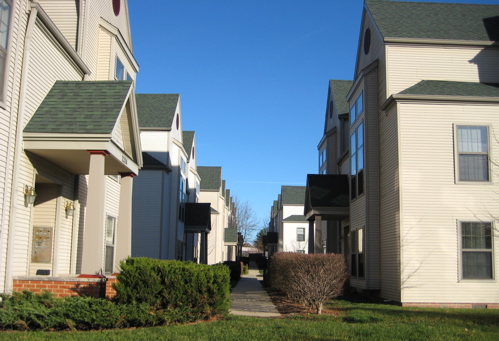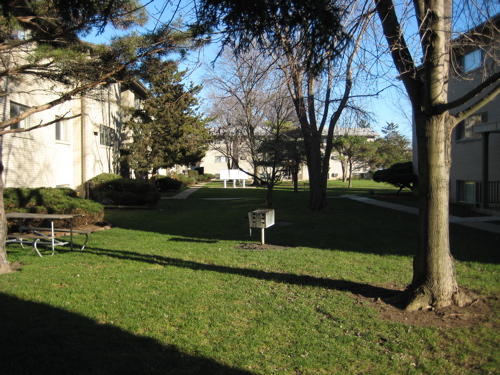The apartment complex where we live was built over the course of a decade or so, back in the 1960s. I don’t know what the building code and zoning rules said about things like building spacing, but I imagine that they left quite a bit up to the builder.
Without rules that had to be followed, the builders built the complex with an eye toward maximizing their profit. If you put more units on a piece of property, you can bring in rent from more tenants. But at some point adding more units leads to diminishing returns—adding more buildings makes the space feel sufficiently cramped or crowded that potential tenants view the place as a downscale complex and they won’t pay as much. For a while that can still be profitable—you gain more from the extra units than you lose to lower rents. But squeezing yet another building in won’t just cut the rent on those units, it’ll cut the rent on all the other units as well. Eventually you reach the point where you lose more in rent than you gain from having extra units, so you stop and don’t build that building.
Zoning regulations can change the dynamic. Currently, there are rules in Champaign that limit apartment builders from jamming ever more buildings into a complex.

This picture is from a newer complex just a few blocks from where we live. The buildings are crammed so close together, it seems to me that you might just as well be living in the same building as your neighbors, as far as noise and privacy go. (This picture shows them face-to-face. Side-to-side they’re even closer.)
Again, I don’t know, but I assume that the buildings are built as close together as zoning regulations allow. That’s the pernicious side-effect of having that sort of rule.
Because, see, there isn’t just one answer to the question of how closely packed buildings can be before they begin to feel downscale. It depends on other stuff. It depends on what people are used to. It depends on what alternatives are available.
When you create a rule, some fraction of the builders are going to aim for the bottom—just meet the rule. Those units aren’t going to be upscale, but there’ll be some people who will rent them.
If there were no rules, of course, some builders might build complexes where the buildings were even closer together than that, but those complexes would seem especially downscale. When you set a minimum, though, everybody who was thinking of someplace in that neighborhood will tend to aim for that same point.
Obviously the people who would have aimed more downscale would be prohibited from doing so. But the people who would have aimed for just slightly better will also be drawn downward. If there were a wide range of densities, builders would see advantages to being just slightly more upscale than the next guy. But with rules setting a lower limit, we don’t see the full range. Instead, we tend to see a binary division between the downscale units that are at the maximum density permitted, versus the upscale units that offer a sufficiently lower density to stand out. The legally mandated minimum becomes normalized (because so many complexes build to that standard) and ends up being a standard, rather than a minimum.

The courtyard outside our apartment is a common area that is actually used by us and our neighbors. There are picnic tables and grills. The space is comfortable. It’s big enough that we don’t feel like we’re sitting right outside our neighbor’s apartments, but not so big that we feel lost in a vast space.
The space outside the nearby complex, though, feels wretched to me. With the buildings so close together, the space between becomes just a dark corridor. It’s not inviting, which is just as well because there’s no room to do anything there anyway.
In one sense, it doesn’t really matter to me. Our complex exists at its present density, and I can’t imagine that it would make any sense to try find find a way to pack in more buildings. But it makes me sad to see all the other, higher-density, complexes going up. It means that we aren’t getting new options.
The rules that set “reasonable minimums” instead are producing a binary distribution, where our only choices are downscale apartments crammed together or high-priced luxury apartments, where tenants get a reasonable density, but are stuck paying for other amenities that we don’t care about. It’s the downside of reasonable rules.
